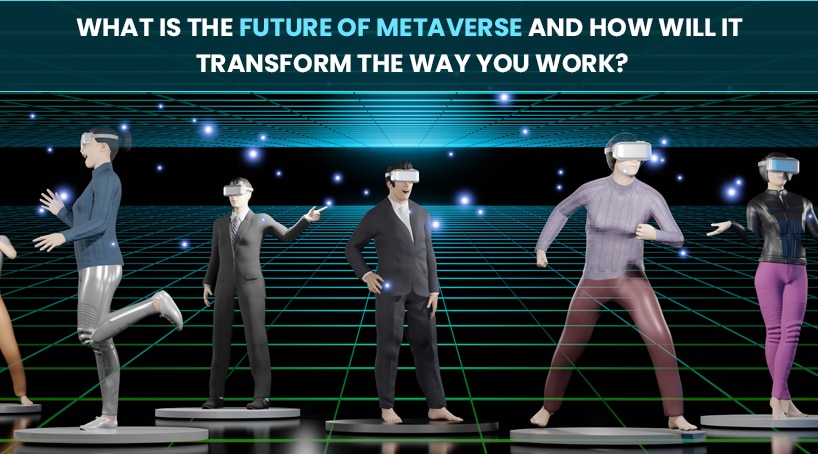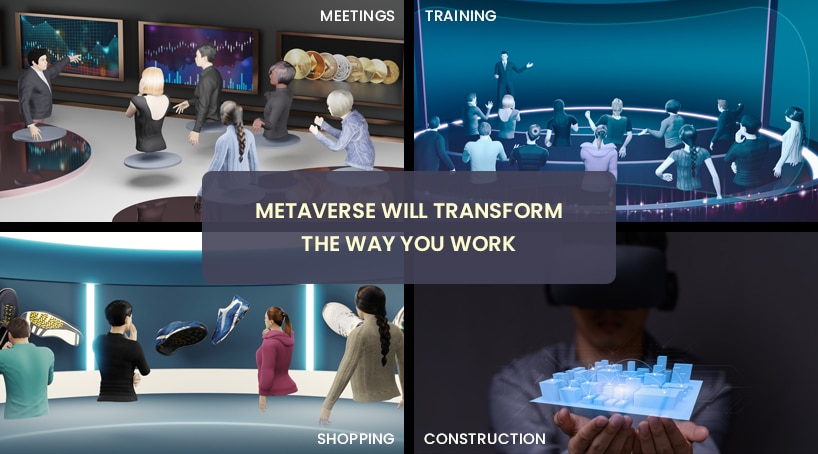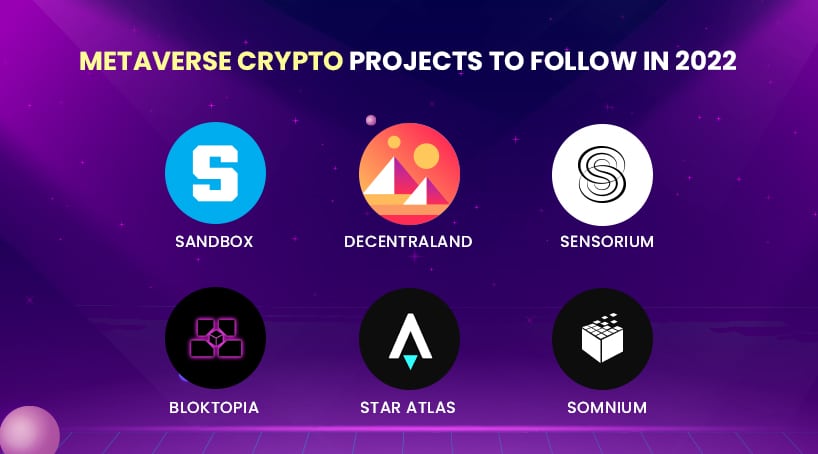- 8 min read
- May 4, 2022
- 0

Metaverse is a virtual reality/augmented reality environment where you may create virtual social interactions. Metaverse can also be described as a three-dimensional digital depiction of the well-known virtual reality gaming experience, and its roots largely lie in the gaming industry.
Metaverse has grown a lot since its humble beginnings and now finds a lot of applications in a variety of industries. People are now using the metaverse not simply to play games, but also to promote their businesses and there are serious considerations for it being used in actual business environments. The question is how, and for now, nothing is set in stone. In this article, we will explore the speculations of what this technology will become in the future.
What Is The Metaverse?
It’s supposed to be an all-encompassing digital environment where users, in the form of avatars, may communicate with one another, go about their daily lives, and have similar experiences to those they’d have in the actual world. It’s simpler to think of the metaverse as a meeting of the physical and digital worlds, connecting the best of both worlds.
However this metaverse in reality is a complex multi-layered virtual world with many different technology layers. To produce high-quality results, immersive 3D environments need a lot of computational power. Another key worry linked with the deployment of the metaverse is security. As a result, there are a number of things that corporations should think about before investing in the metaverse.
Following are some things that form different parts of the metaverse.
- Hardware: Mobile devices, VR headsets, AR devices and similar hardware
- Software: Blockchain, IoT, mobile applications, artificial intelligence, and virtual reality
- Infrastructure on which it is built: Cloud services, high speed internet(5G), GPUs and similar infrastructure
- Additional technology: The metaverse needs additional spatial modeling technologies like 3D visualization and supporting rendering frameworks.
It serves and is supported by the digital economy of eCommerce, digital asset rights, media and design companies etc. While this may all seem speculative, a handful of the world’s most influential tech companies have actually taken the plunge and integrated the metaverse into their operations using metaverse development.
The recent popularity of the metaverse
These days even laymen have now heard the term “metaverse”, even though they may not know what it is truly capable of. Within the next eight years, the worldwide metaverse industry is predicted to increase its financial value by as much as 40%, reaching almost $670 billion by 2030. The growing popularity of the metaverse can provide a plethora of chances for technology businesses to build interoperable metaverses.
Here are some reasons why Metaverse has become popular:
- Big tech companies like Facebook and Microsoft are building their own versions of the metaverse. Facebook also changed its name to meta.
- The gaming industry already is hyped to get metaverse integrations
- Many businesses have now understood the potential of the metaverse to bring them profits
- Blockchain, NFTs, and gaming technology has evolved considerably to make the once almost fictional metaverse into reality
- Metaverse developer jobs are increasing and businesses are actively making their own version of the metaverse for whatever reason they fit.
Metaverse will transform the way you work

Metaverse is all set to transform the way people do work, and we predict the following developments will occur in this decade as technology develops.
Remote meetings will be more effective through the metaverse
The number of real-life meetings and conferences will be drastically reduced thanks to avatars and holograms in the metaverse. Mesh, a technology developed by Microsoft, allows individuals to collaborate as if they were physically present in the same room. Future metaverses will make it much easier and more efficient for team members to congregate as 3D avatars or holograms in a virtual world. They’re probably going to utilize their webcam to animate a 3D avatar by tracking the user’s face and motions.
Metaverse in manufacturing & design industries
The metaverse will allow enormous enterprises to solve problems and develop in real-time. Boeing has previously said that their next jet would be built in the metaverse. Sensors and robots will be able to test software and replicate real-world physical integrations in the metaverse before introducing them into the real world. Customers will also be able to assist in the production process from the start, offering input on such new items from the metaverse without putting their health and safety at risk.
Metaverse will create new jobs
Existing jobs will be dramatically altered, and new ones will be created as a result of the metaverse. Jobs that formerly needed in-person connection will now have virtual possibilities, resulting in a massive increase in freelancing and remote job prospects. Many jobs in the software development sector will be created owing to the sophistication of the metaverse. There are also possibilities that new jobs will be created within the metaverse.
Metaverse will change shopping
Consumers will shop from the comfort of their own homes, selecting things in the metaverse, making purchases, and waiting for delivery. Once the item has been recognised, a robot at an automated warehouse will locate a replica, pack it, and ship it. Cryptocurrencies will become the main means of purchasing and selling objects in the metaverse, enhancing user privacy and transaction security while also speeding up transactions.
Metaverse will help train people effectively
Microsoft is developing headsets that will allow US army soldiers to see where they are and what they’re up against by projecting holographic visuals, three-dimensional topographic maps, and a compass onto their field of vision. Simulating an environment, which may later be used to train individuals for various tasks, can be done using comparable strategies through the metaverse. Driving, airplane training, and other sorts of specialist equipment use are some instances of where this strategy might be applied.
Metaverse Crypto Projects To Follow In 2022

To finish up with the speculations, here are many crypto projects that have gained a significant following and are expected to further the use and development of the metaverse.
Sandbox
Sandbox is a token used in blockchain-based games in the metaverse and metaverse world, where you may purchase, sell, and claim non-fungible token assets like virtual plots of land. Both the NFT marketplace and the Sandbox’s UGC gaming technology are exclusive to the Sandbox metaverse. Land and property may be purchased by gamers to enhance their online gaming experiences. SAND is its own cryptocurrency that can be bought and traded on Binance.
Decentraland
Decentraland, a virtual digital environment that replicates the actual world, was launched in 2015. In it one may meet individuals from all around the world by attending online events, playing online games, and selling digital things in marketplaces. MANA is its own cryptocurrency and can be bought or traded on major cryptocurrency exchanges such as Binance and others. The players control every virtual item in Decentraland. On the Ethereum blockchain, MANA is often utilized to create virtual property ownership.
Sensorium
Sensorium Galaxy is a digital metaverse created in partnership with some of the world’s most renowned artists, producers, and media businesses. It is presently in the beta stage. SENSO is the company’s own cryptocurrency, which uses blockchain technology to fuel a decentralized economy that is fair, transparent, and user-owned. This token may be used for a variety of transactions, including the creation of new avatars, the purchase of event tickets, and the creation of creative content.
Bloktopia
The bloktopia metaverse features a 21 storey simulated tower. Members of Bloktopia may create avatars, engage in social activities, learn about cryptocurrency, and trade it in its metaverse. Real-time 3D production engines are capable of producing virtual reality visual effects the metaverse is famous for. The Bloktopia blockchain is built on the Polygon blockchain.
Star Atlas
Star Atlas is a next-generation virtual reality game built on a metaverse. Star Atlas is built on the Solana blockchain. It may be used to buy digital assets like ships, people, land, and machinery with the help of solana. There are no high expenses or concerns with scalability within the game, which is attractive to a lot of users.
Somnium
Somnium Space is a metaverse for video game and NFT phenomena. It gives users many 3D avatar experiences. Using Somnium’s WebXR technology, anybody may see the Metaverse online. Somnium Space chose Polygon to provide worldwide accessibility while transferring items to increase their worth.
Conclusion
As you can see, metaverse hasn’t even reached half of its potential in the tech market yet, and all tech giants are developing their own versions of the metaverse, one even renaming themselves meta in the process.
Metaverse can present incredible growth opportunities for online businesses, and to unlock such opportunities they should partner up with a good metaverse development company like nextbrain. Nextbrain has years of experience in both blockchain development and metaverse development services. It is the premier Canadian company that businesses turn to when they have issues in such matters.
